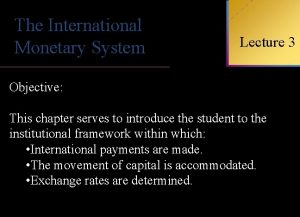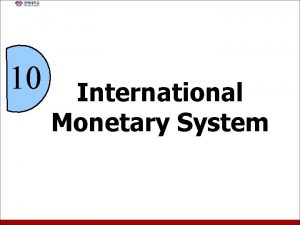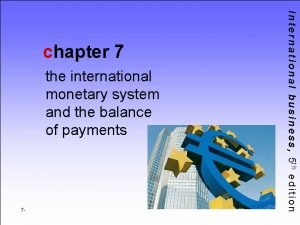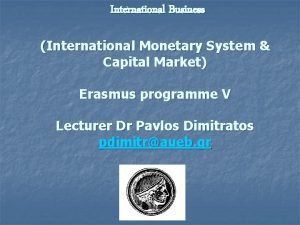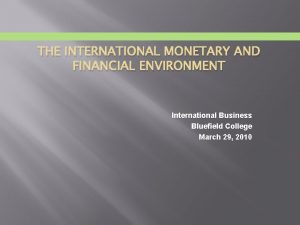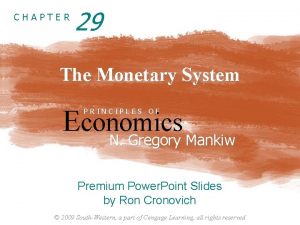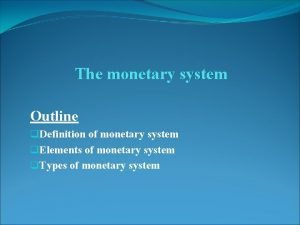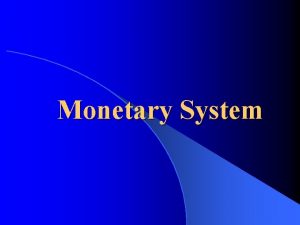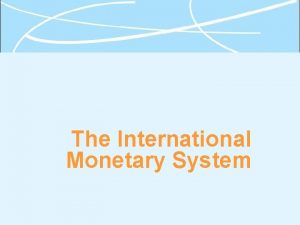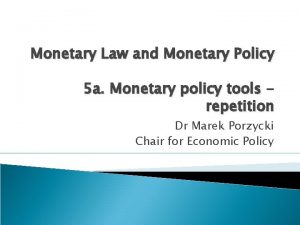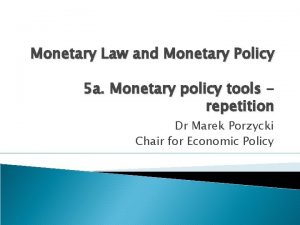Evolution Of International Monetary System Gold StandardUntil July












- Slides: 12

Evolution Of International Monetary System • • Gold Standard—(Until July 1944) The Bretton Woods System-(Since July 1944 ) • Before 15 August 1971 • After 15 August 1971 • Jamaica Agreement Jan 1976

Evolution Of International Monetary System • • Gold Standard The system of monetary organization under which the value of a country’s money is legally defined as a fixed quantity of gold, and domestic currency takes the form of gold coin and/or notes convertible on demand into gold at legally determined rates. For a full gold standard to exist requires two basic conditions: – the obligation of the monetary authority to exchange domestic currency for gold to any amount at the specified rates and – the freedom of individuals to import and export gold.

Evolution Of International Monetary System • Historically, there have been three variant forms of the gold standard: • The gold circulation standard • The gold bullion standard • The gold exchange standard

Evolution Of International Monetary System • The gold circulation standard – when gold coin was in active circulation and the authority’s selling obligation was to sell gold coin, • The gold bullion standard – when gold coin was not in active circulation, free minting was suspended, and the authority’s selling obligation was to sell gold in bar form,

Evolution Of International Monetary System • The gold exchange standard – under which a country pegged the value of it’s currency to the value of the currency of a center country which was itself on gold. The pegging was effected by the monetary authorities holding all or part of the country’s external reserves in reserve currency assets, and by exchanging the domestic currency for the reserve currency at determined and stable rates.

Evolution Of International Monetary System • • • The Bretton Woods System It was agreed in July 1944 and ratified in December 1945. It was based upon a policy of : – – Fixed Exchange Rates, the elimination of exchange restrictions, currency convertibility, and the development of a multilateral system of international payments. Exchange rtes were based on a par value system which required member countries to constrain fluctuations in their exchange rates within a margin of plus or minus one per cent round a par value expressed in terms of US Dollar, which in turn were directly convertible into gold at a fixed rate of 35 dollar per one fine of ounce of gold.

Evolution Of International Monetary System • • Although each country’s exchange rate was fixed , it could be changed – devalued or revalued against the dollar – if the IMF agreed that the country’s balance of payments was in a situation of “ Fundamental Disequilibrium “. The term fundamental disequilibrium was meant to cover countries that suffered permanent adverse international shifts in the demand for their products This flexibility however was not available in the case of US Dollar (as it was fixed in terms of Gold ).

Evolution Of International Monetary System • • Due to the factors mainly related to military expenses and the overheating of the US economy from the war in Vietnam, the dollar came under downward pressure in the late 1960 s and early 1970 s. On 15 August 1971, President Nixon stopped conversion of the dollar into gold, thus ending the international monetary system that had been set up at Bretton Woods.

Evolution Of International Monetary System • • Since the Dollar was no longer supported by gold conversions, most exchange rates were allowed to float in world money markets from August – December 1971, when a new world monetary agreement, known as the Smithsonian Agreement, was adopted. Under this agreement, convertibility between gold and dollar was not restored, but theoretical gold value of the dollar was devalued by 8. 00 per cent ; i. e. the price of gold was raised from $35 to $38 per ounce. Most other major currencies were valued up against the dollar by various amounts. To permit greater flexibility in exchange rates, fluctuations were permitted within 2. 25% of parity instead of within 1% as under Bretton Woods system.

Evolution Of International Monetary System • • • In spite of high hopes for it’s success, the Smithsonian agreement lasted only 14 months. Market pressures were too great for the pegged-exchangerate system to survive. The Pound Sterling floated in June 1972, the Swiss Franc floated in January 1973. By February 1973 it became evident that the revaluation against the dollar had been insufficient. The dollar was devalued an additional 10%, thus raising the official price of gold to $42. 25 per ounce.

Evolution Of International Monetary System • • • But this devaluation also was found to be insufficient to stabilize the dollar and since March 1973 most of the currencies of the world have been floating. The float was officially sanctioned at an IMF meeting in Jamaica in January 1976 in the form of amendments in the Articles of Agreement of the IMF. This floating-exchange-rate regime is still in effect today.

Bretton Woods Institutions IMF World Bank IBRD IDA IFC
 International monetary system
International monetary system Objectives of international monetary system
Objectives of international monetary system International monetary system
International monetary system International monetary system
International monetary system International monetary fund apush
International monetary fund apush International monetary and financial environment
International monetary and financial environment International financial environment
International financial environment International monetary fund
International monetary fund International monetary fund
International monetary fund Chapter 29 the monetary system
Chapter 29 the monetary system Meaning of monetary system
Meaning of monetary system Evolution of global marketing
Evolution of global marketing Harris burdick oscar and alphonse
Harris burdick oscar and alphonse
